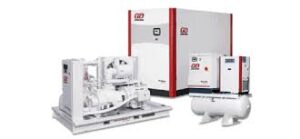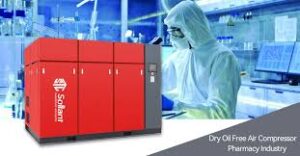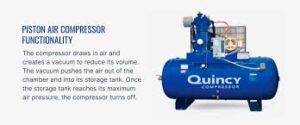Compressors Machinery: An In-Depth Overview 
Compressors are vital machines used in various industrial, commercial, and residential applications. They play a crucial role in converting power into potential energy stored in compressed air or gas. This comprehensive overview will explore the different types of compressors, their working principles, applications, selection criteria, maintenance practices, and recent technological advancements.
- Introduction to Compressors
1.1 Definition and Function
A compressor is a mechanical device that increases the pressure of a gas by reducing its volume. This process, known as compression, involves the application of energy to move gas molecules closer together, thereby increasing pressure. Compressors are essential in a wide range of industries, from manufacturing and refrigeration to air conditioning and automotive applications.
1.2 Importance of Compressors
Compressors are crucial for:
- Energy Efficiency: By compressing gases, they facilitate energy storage and transportation.
- Process Control: In industrial applications, they help maintain specific pressure levels for processes like chemical reactions and material handling.
- Environmental Management: Compressors are used in systems that reduce emissions and control pollutants.
- Types of Compressors
Compressors can be classified based on their working principles, applications, and the type of gas they compress. The two primary categories are positive displacement compressors and dynamic compressors.
2.1 Positive Displacement Compressors
Positive displacement compressors work by trapping a fixed amount of gas and forcing it into a smaller volume. They are further divided into two main types:
2.1.1 Reciprocating Compressors
Reciprocating compressors use a piston-driven mechanism to compress gas. Key characteristics include:
- Components: They consist of a cylinder, piston, crankshaft, and valves.
- Operation: The piston moves up and down in the cylinder, drawing gas in during the downward stroke and compressing it during the upward stroke.
Applications
- Industrial Manufacturing: Used for powering pneumatic tools and machines.
- HVAC Systems: Employed in air conditioning and refrigeration systems.
- Automotive Industry: Utilized in fuel injection systems and air conditioning.
2.1.2 Rotary Compressors
Rotary compressors utilize rotating elements to compress gas. They include:
- Screw Compressors: Use two interlocking screws to compress gas.
- Vane Compressors: Feature sliding vanes that rotate within a cylinder.
Applications
- Industrial Applications: Commonly used in manufacturing and process industries for air supply.
- Refrigeration: Employed in large commercial refrigeration systems.
2.2 Dynamic Compressors
Dynamic compressors, also known as centrifugal compressors, use high-speed rotating impellers to impart kinetic energy to the gas, converting it into pressure.
2.2.1 Centrifugal Compressors
Centrifugal compressors increase gas pressure by converting kinetic energy from the rotating impeller into potential energy. Key features include:
- High Flow Rates: Suitable for large volumes of gas.
- Compact Design: Often smaller and lighter than positive displacement compressors.
Applications
- Power Generation: Used in gas turbines and industrial processes.
- Oil and Gas: Employed in pipelines for transporting natural gas.
2.3 Other Types of Compressors
2.3.1 Scroll Compressors
Scroll compressors consist of two spiral elements that compress gas as they rotate. They are known for their quiet operation and high efficiency, making them popular in air conditioning applications.
2.3.2 Diaphragm Compressors
Diaphragm compressors use a flexible diaphragm to compress gas, providing a leak-free operation. They are commonly used in applications requiring high purity, such as in the pharmaceutical and food industries.
- Working Principles of Compressors
3.1 Positive Displacement Compressors
In positive displacement compressors, gas is confined within a chamber and reduced in volume, thereby increasing pressure. The key steps include:
- Intake Phase: The piston or rotary element moves to create a vacuum, allowing gas to enter the chamber.
- Compression Phase: The moving part compresses the gas, increasing its pressure.
- Discharge Phase: The compressed gas is expelled from the chamber through a discharge valve.
3.2 Dynamic Compressors
Dynamic compressors operate on a different principle. Here’s how they work:
- Gas Intake: Gas enters through an inlet and is drawn into the impeller.
- Acceleration Phase: The impeller rotates rapidly, imparting kinetic energy to the gas.
- Diffusion Phase: The high-velocity gas exits the impeller and enters a diffuser, where its velocity decreases, and pressure increases.
- Applications of Compressors
Compressors are utilized across diverse industries and applications. Key areas include:
4.1 Manufacturing
In manufacturing, compressors provide compressed air for various tools and processes, including:
- Pneumatic Tools: Powering drills, hammers, and wrenches.
- Material Handling: Assisting in conveying and packaging processes.
4.2 HVAC Systems
Compressors are integral to heating, ventilation, and air conditioning systems, responsible for:
- Cooling: Compressing refrigerants to facilitate heat exchange in cooling systems.
- Heating: In heat pumps, compressors help transfer heat for heating applications.
4.3 Oil and Gas
In the oil and gas industry, compressors are used for:
- Gas Transmission: Compressing natural gas for transportation through pipelines.
- Gas Processing: Enhancing the efficiency of gas extraction and processing operations.
4.4 Refrigeration
Compressors are essential in refrigeration systems, helping to maintain desired temperatures in:
- Commercial Refrigeration: Cooling food and beverages in supermarkets and restaurants.
- Industrial Refrigeration: Used in large-scale cooling systems for manufacturing processes.
4.5 Automotive
In the automotive sector, compressors serve various functions:
- Air Conditioning: Compressing refrigerants to provide cooling in vehicles.
- Engine Management: Supporting fuel injection systems in modern engines.
- Selecting the Right Compressor
Choosing the right compressor for a specific application involves several considerations:
5.1 Application Requirements
Understanding the specific needs of the application is critical. Factors include:
- Flow Rate: The volume of compressed gas required.
- Pressure Range: The desired operating pressure.
- Gas Type: The nature of the gas being compressed (air, refrigerants, natural gas).
5.2 Efficiency and Performance
Selecting an energy-efficient compressor can lead to significant cost savings. Considerations include:
- Energy Consumption: Assessing the power requirements and operational costs.
- Performance Characteristics: Evaluating performance curves and efficiency ratings.
5.3 Maintenance and Support
Evaluate the maintenance requirements and support options available for the chosen compressor. Consider:
- Service Intervals: The frequency and type of maintenance required.
- Availability of Parts: Ensuring that spare parts and support services are readily available.
5.4 Budget Considerations
The initial purchase price is important, but also consider:
- Total Cost of Ownership: Evaluating long-term operational costs, including maintenance, energy consumption, and potential downtime.
- Maintenance of Compressors
Proper maintenance is crucial to ensure the reliability and longevity of compressors. Key maintenance practices include:
6.1 Regular Inspections
Conducting regular inspections helps identify potential issues before they escalate. This includes:
- Visual Inspections: Checking for leaks, wear, and damage.
- Performance Monitoring: Analyzing operational data for any deviations from normal performance.
6.2 Lubrication
Ensuring proper lubrication of moving parts is essential for smooth operation. Key practices include:
- Regular Oil Changes: Changing oil according to manufacturer recommendations.
- Checking Oil Levels: Monitoring oil levels and replenishing as needed.
6.3 Filter Maintenance
Air and oil filters should be inspected and replaced regularly to ensure optimal performance. Clogged filters can lead to decreased efficiency and increased wear on components.
6.4 Troubleshooting Common Issues
Familiarity with common compressor issues can aid in troubleshooting. Common problems include:
- Excessive Vibration: May indicate misalignment or imbalance in rotating components.
- Overheating: Can be caused by insufficient lubrication or blocked airflow.
- Technological Advancements in Compressors
The compressor industry is continually evolving, driven by technological advancements aimed at improving efficiency, reliability, and performance.
7.1 Smart Compressors
The integration of IoT and smart technologies allows for real-time monitoring and control of compressor systems. Benefits include:
- Remote Monitoring: Enabling operators to track performance and receive alerts for maintenance needs.
- Data Analytics: Leveraging data to optimize performance and predict failures.
7.2 Variable Speed Drives (VSD)
VSD technology allows compressors to adjust their speed based on demand, leading to significant energy savings and enhanced performance. Key advantages include:
- Energy Efficiency: Reducing energy consumption during low-demand periods.
- Improved Control: Providing better control over pressure and flow rates.
7.3 Advanced Materials
The development of advanced materials contributes to the durability and efficiency of compressors. Innovations include:
- Lightweight Alloys: Reducing the weight of components while maintaining strength.
- Corrosion-Resistant Coatings: Enhancing the longevity of compressors in harsh environments.
7.4 Enhanced Control Systems
Modern compressors are equipped with advanced control systems that improve operational efficiency. Features include:
- Automated Controls: Streamlining operation and reducing manual intervention.
- Diagnostic Capabilities: Allowing for quick identification of issues and optimizing performance.
- Conclusion

Compressors are integral to numerous applications across various industries, providing essential functionality for efficient operation. Understanding the different types of compressors, their working principles, and the factors influencing their selection and maintenance is crucial for optimizing performance and longevity.
As technology continues to advance, the compressor industry is poised to become more efficient, intelligent, and sustainable. Embracing these advancements while adhering to best practices in maintenance and operation will ensure that compressors remain vital components in the machinery landscape for years to come.

